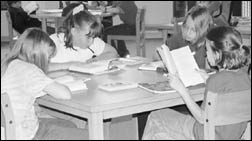 Students are so excited about the accelerated reading program they are reading in their free time in and out of class. They can be found reading books at home, in the hallways before school, in their classrooms, and in the library at the Paynesville Area Elementary and Middle School.
Students are so excited about the accelerated reading program they are reading in their free time in and out of class. They can be found reading books at home, in the hallways before school, in their classrooms, and in the library at the Paynesville Area Elementary and Middle School.This is the second year the accelerated reading program has been in the middle school and the staff members are excited about how anxious the students are to read books. With 1,400 books in the program in the library, the school is wondering if they have enough books to meet the student's needs.
"The students are checking out three to five books at a time," Jo Flanders, middle school librarian, said. The program was first introduced at the elementary school three years ago. After seeing the results of the program, it was expanded into the middle school last year for the sixth graders.
The seventh graders started the program during the fourth quarter. This year, the eighth graders were introduced to the accelerated reading program last spring.
"Accelerated reading is a great way to promote independent reading," said Deb Gillman, middle school principal.
At the start of the year, each student is given a test to find their reading level. Reading levels range from 1.0 to 12.9 Students are given tests three times a year to access their reading levels. The students are then placed in a zone of proximinal development (ZPD), such as 5.7 to 11.5. This allows them to read a variety of books within their reading level.
"The zones are comfortable for the student yet provide a challenge," eighth grade communications teacher Laura Viaene said.
The library books are color coded for easy identification. Each color indicates a different zone or reading level.
"After the students read their library books, they are able to be tested on what they have read," Viaene said.
The tests vary anywhere from five to 20 questions, depending on the thickness of the book and whether it is a fiction or nonfiction book, said Rita Brossard, elementary librarian. Brossard urges students to read short books several times before taking the test.
The students earn points for each test. The more correct answers, the more points they earn. The amount of points students can earn per book are indicated on the inside cover of the book.
The students have learned that they need to read the entire book. They can't skim through the book as the tests are specific about things in each book. "The actual reading isn't hard," said Brossard, "it's the test asking five specific facts that's hard."
In the eighth grade, 20 percent of the communications grade is determined by how many points they have earned.
"I don't expect each student to get 100 percent on every test, 80 percent is acceptable," Viaene said. She encourages students to select books that will challenge them.
A computer prints out the quiz results, the book level, points earned, and the number of quizzes the student has taken thus far. The computer even lists the books the students have read.
"It's overwhelming how much information the computer can print out on each student," Viaene said.
Viaene said the accelerated reading program encourages independent reading practice. It gives students a broad choice to select from. Students can read books on sports, adventure, fiction and nonfiction. If they select a book which is too difficult, they can try again, and take a different book.
"The amount of books the students have been checking out is amazing," Viaene said. "It's fun to see kids sitting around reading," she added.
The middle school was fortunate that they had a lot of the books required for the accelerated reading program already in the library, the books only needed coding. At the elementary school, they have 5,000 books available for students to read as part of the program.
According to Viaene, the students can't read an abridged version of a book, as they would not be able to pass the test.
The students recommend books they have enjoyed reading to their classmates.
"Our biggest challenge is keeping enough books in the library," Gillman said. Return to Archives